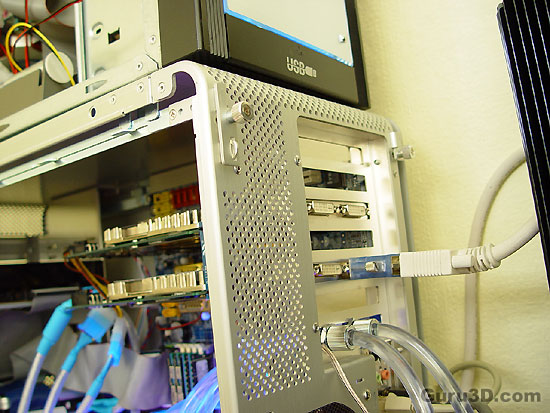Page 2
SLI Explained
Although adopting the similar name 'SLI' as used in the 3dfx era, the two really can not be compared. We are not going in-depth as you all understand the principles and ideas of utilizing two graphics cores. The technology behind that is fascinating yet not something most of you really care about, we'll handle a short explanation though.
First I like to tell you something about the graphics card's memory (we call it framebuffer). It's 256 MB per graphics card and thus core. Some of you think that two cards of 256 MB will; get you a 512 MB framebuffer solution. While that's physically correct it simple does not work that way. You cannot look at the combined cards as a 512 MB model. It's quite shady but textures and graphics data are in fact cloned in both frame buffer in a 1:1 way so you're basically looking at 256 Mb effective. That being said, let's walk quickly through SLI.
SLI is short for Scalable Link Interface.
Most GeForce 6600, 6800 and now 7800 models have an internal architecture that allows the graphics core's to work in pairs. When the two GPU's work in pairs (parallel) they'll start load-balancing the workload. To explain it very simply I'll throw in a small explanation of one of the rendering methods. Each graphics core can render either the upper or lower half of the screen. The frame (single image) is divided in two, calculated and then merged back together.
You can understand that this requires some hefty CPU power so you better be sure to have a high-end processor in your PC. And with High-end I really mean a Pentium 4 3.4 GHz, Athlon 64 3200+ or equivalent for the Series 6 products and even faster (3400+) for Series 7, at minimum.

Once you installed your drivers new SLI options become available.
When you have a SLI capable solution active (see above picture) rendering can take place in three modes. If your game is not supported automatically Single GPU rendering will be enabled. When the game does support SLI then the driver will select the best SLI mode, which is either Alternate (AFR) or Split Frame (SFR) rendering. Let's have a quick explanation on them.

Among the new options SLI rendering modes
SFR - Split frame rendering. Each graphics core is going to render a part of the screen, split horizontally. One card is responsible for the top section of the screen, the secondary card is responsible for the bottom. That situation is then load balanced as described above.
AFR - Alternate frame rendering. Each graphics core is rendering a frame at a time, odd and even. The full frame is prepared by the CPU and forwarded to the driver, which makes it render on each device to render a frame in turn. This is interleaving. First card A does a frame then card B the other.
It seems AFR is NVIDIA's preferred method of rendering while using SLI. However SFR, I think, would be the way to go performance wise. But it boils all down to whether the game can handle it or not.
The driver support for SLI has improved bigtime. The new 77.72 drivers we used in this article allowed SLI to work straight out of the box. Quite impressive actually as this was definitely not the deal the first time we tested SLI.

